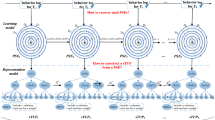Abstract
“U-Business” is a novel type business environment, which can provide various services via many mobile devices. In order to provide personalized service to different users, user model (UM) can play an important role in U-Business. UM reflects some characteristics of users to a certain degree, which is used widely in U-Business, like personalized recommendation, social computing, information retrieval services, and so on. Currently, there are more and more researchers who focus on the building and update of UM based on the activities of people. However, as too many UM appeared, the number of UM in cyber space is increasingly large, which takes a lot of space and cost. Furthermore, after some users disappear in the physic world, their models are still working in the cyber world. This case is not reasonable obviously, but few researches take care about it. Therefore, one of important issues, the death of UM should be taken into account in the whole life-cycle of user model. This paper proposes a specific user modeling method for the Cyber Individuals (Cyber-I) in U-Business. The essential difference between this UM and traditional ones is that it has a life, that is, birth, growth, and demise, like a life-cycle of Cyber-I. Specially, the significance of UM life ending and five states of UM death are described from an organic viewpoint. In addition, there is a framework of the whole life process of UM. Finally, the proposed idea is applied to the field of personalized service.






Similar content being viewed by others
Abbreviations
- UM:
-
User model
- Cyber-I:
-
Cyber individual
- Rea-I:
-
Real-individual
References
Kunii TL, Ma J, Huang R (1996) Hyperworld modeling. In: Proceedings of international conference visual information systems (VIS 96). pp 1–8
Ma J, Wen J, Huang R et al (2011) Cyber-individual meets brain informatics. IEEE Intell Syst 26(5):30–37
Asada M et al (2009) Cognitive developmental robotics: a survey. IEEE Trans Auton Mental Dev 1(1):12–34
Clarke R (1994) The digital persona and its application to data surveillance. Int J Inf Soc 10(2):77–92
Jochem H, Ralph B, Frank W (1999) WebPlan: dynamic planning for domain specific search in the internet. Available: http://wwwagr.informatik.uni-kl.de/~webplan/PAPER/Paper.html
Roldano C (1999) User profiling with bayesian belief networks. Available: http://www.labs.bt.com/profsoc/facts/workshop/abstract/BBN.html
Intarka Inc.: ProspectMiner (2000), http://www.intarka.com
Adomavicius G, Tuzhilin A (2005) Toward the next generation of recommender systems: a survey of the state-of-the-art and possible extensions. IEEE Trans Knowl Data Eng 17(6):734–749
Linden G, Smith B, York J (2003) Amazon.com recommendations: item-to-item collaborative filtering. IEEE Internet Comput 7(1):76–80
Sarwar BM, Karypis G, Konstan J, Riedl J (2001) Item-based collaborative filtering recommendation algorithms. In: Proceedings of the 10th international world wide web conference. Hong Kong, China, pp 285–295
Cantador I, Castells P (2011) Extracting multilayered communities of interest from semantic user profiles: application to group modeling and hybrid recommendations. Comput Human Behav 27:1321–1336
Ebbinghaus H (1964) Memory: A contribution to experimental psychology. Dover, New York
Collins AM, Loftus EF (1975) A spreading-activation theory of semantic processing. Psychol Rev 82(6):407–428
Elmisery AM, Botvich D (2011) Enhanced middleware for collaborative privacy in IPTV recommender services. J Convergence 2(2):33–42
Zhong N et al (2007) Web intelligence meets brain informatics. In: Proceedings of 1st WICI international workshop web intelligence meets brain informatics. LNAI 4845, pp 1–31
Zhong N, Motomura S (2009) Agent-enriched data mining: a case study in brain informatics. IEEE Intell Syst 24(3):38–45
Pyshkin E, Kuznetsov A (2010) Approaches for web search user interfaces: how to improve the search quality for various types of information. J Convergence 1(1):1–8
Ma J (2005) Smart u-things and ubiquitous intelligence. Embed Softw Syst LNCS 3820:776
Ma J et al (2005) Towards a smart world and ubiquitous intelligence: a walkthrough from smart things to smart hyperspaces and UbicKids. Int J Pervasive Comput Commun 1(1):53–68
DafirEch-Cherif El Kettani M, En-Nasry B MIdM: an open architecture for mobile identity management. J Convergence 2(2):25–32
Acknowledgments
This work is supported by Shanghai Leading Academic Discipline Project (J50103) and Innovation Program of Shanghai Municipal Education Commission (11ZZ85).
Author information
Authors and Affiliations
Corresponding author
Rights and permissions
About this article
Cite this article
Zhang, B., Zheng, J., Ma, J. et al. Research on life-cycle of user model in U-Business. Pers Ubiquit Comput 17, 1449–1457 (2013). https://doi.org/10.1007/s00779-012-0580-8
Received:
Accepted:
Published:
Issue Date:
DOI: https://doi.org/10.1007/s00779-012-0580-8




